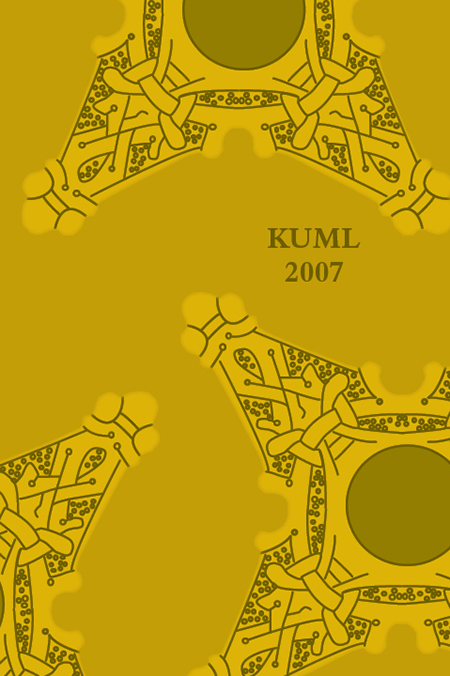Monumentale skibssætninger i Danmark og Skåne
DOI:
https://doi.org/10.7146/kuml.v56i56.24680Nøgleord:
monumentale skibssætninger, Danmark, SkåneResumé
Monumental Ship-Settings in Denmark and Scania
This paper, based on the author’s thesis, evolved from an attempt to determine the age, function, background and symbolism of seemingly grave-less monumental ship-settings – i.e. ship-settings with a length of at least 40 metres and constructed from large standing stones. The monumental ship-settings examined in this paper are (or were) located at Vejerslev, Jelling, Bække, Glavendrup, Lejre and Tryggevælde in present-day Denmark and at Södra Ugglarp, Kåseberga, Torup, Färlöv and Ljungarum in present–day Scania (figs. 1, 2, 4, 6, 7 and 9).
The archaeological evidence and scientific dates suggest that monumental ship-settings in Denmark were erected in the period leading up to the conversion to Christianity – approximately AD 900-970. The corresponding sites in Scania could very well be contemporary but some may be slightly older, and some may even date back to the Bronze Age. This uncertainty is due to the fact that the Scanian examples can only be dated typologically or by radiocarbon . Both methods are fairly inaccurate.
Most of the smaller ship-settings contain graves, predominantly cremation graves, whereas the monumental ship-settings often to not contain graves and gravegoods. Based on the lack of grave-related finds in monumental ship-settings, this paper reaches the conclusion that it is not possible to demonstrate that monumental ship-settings served as monumental tombs. However, several of the monumental ship-settings have been disturbed in numerous ways and a number of them could theoretically have contained graves which are no longer detectable. It is also possible that the monuments may originally have contained graves, which were later destroyed or removed by the deceased’s Christian descendants in connection with a new Christian burial of the deceased. However it is emphasized that, on the basis of the archaeological evidence, it can not be concluded that monumental ship-settings are monumental graves.
Their great dimensions and the siting of monumental ship-settings on high ground and near main transport routes, indicate that these monuments were intended to be seen and admired. At Jelling and Lejre, the locations of known royal and cultic centres coincide with monumental ship-settings (the archaeological and topographical observations made in this article are shown in figure 5). This situation, and the occasional direct connection with rune-stones mentioning kings, warriors and heathen priests, seems to link monumental ship-settings to an upper class or social elite who were probably also responsible for leading the cult. It is therefore concluded that monumental ship-settings were probably erected by an aristocracy or social elite. The monuments often contain postholes, fireplaces and burnt animal bones and it is suggested that they functioned as a cultic site associated with a pre-Christian Norse fertility cult.
The seemingly grave-less monumental ship-settings have, on several occasions, been interpreted as cenotaphs – i.e. commemorative monuments constructed in remembrance of a deceased person but without a grave. As no definite graves have been found in monumental ship-settings (except from at Lejre) this theory is plausible even though it seems a little too “simple”. Commemorative rune-stones (fig. 3 and 8), associated with some of the Danish monumental ship-settings, can be seen as lending support to the cenotaph theory. It cannot therefore be entirely refuted and it seems probable that monumental ship-settings served, in part, as cenotaphs and commemorative monuments in remembrance of a master builder and his family.
As these monuments were erected in the period leading up to southern Scandinavia becoming Christian, it is suggested that they should be understood as a means of securing and underlining a sense of heathen Norse identity at a time of political and religious change. It is stressed that the ship as a symbol can be perceived as the ship Skiðblaðnir and, accordingly, an attribute of the fertility god Freyr. The ship symbolism could very well be seen as a means of demonstrating opposition to the Christian cross and Christianity. Some of the monumental ship-settings include stones decorated with cup marks – allegedly Bronze Age holy symbols – and some are physically linked to Bronze Age barrows. This obvious reuse can be seen as an attempt to stress links with the past in a sort of heathen renaissance shortly before or during the process of conversion to Christianity.
Finally it is suggested that the ship symbol, in the form of a monumental ship-setting, could also have been used by a master builder as a means of claiming royal and divine descent and thus underlining his legitimacy as a ruler and leader of the cult – assuming that the ship symbol is interpreted as the mark of Freyr or Odin.
Felix Vestergaard
Horsens Museum
Downloads
Publiceret
Citation/Eksport
Nummer
Sektion
Licens
Fra og med årgang 2022 er artikler udgivet i Kuml med en licens fra Creative Commons (CC BY-NC-SA 4.0).
Alle tidligere årgange af tidsskriftet er ikke udgivet med en licens fra Creative Commons.


